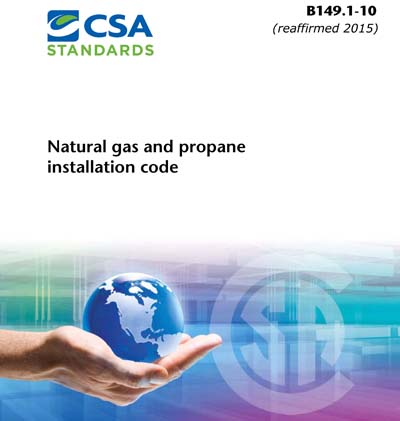Historical
CSA B149.1-2010 (R2015)
B149.1-10 (R2015) - Natural gas and propane installation code
Update(s) to this standard are available. Click Here to download any updates and/or register for email notification of future updates.
ONTARIO CUSTOMERS: Ontario Acts & Regulations document for use with B149.1-10, B149.2-10, B149.3-10, B149.5-10 can be obtained by visiting www.tssa.org.
Preface
This is the fourteenth edition of CSA B149.1, Natural gas and propane installation code. It supersedes the previous editions, published in 2005 and 2000 by the Canadian Standards Association (CSA) as CAN/CSA-B149.1, in 1995, 1991, 1986, 1980, 1978, 1976, and 1974 by the Canadian Gas Association (CGA), and in 1971, 1966, 1962, and 1958 by the Canadian Standards Association.Scope
1.1 This Code applies to the installation of (a) appliances, equipment, components, and accessories where gas is to be used for fuel purposes; (b) piping and tubing systems extending from the termination of the utility installation or from the distributor's propane tank; (c) vehicle-refuelling appliances and associated equipment meeting the requirements of a general-purpose appliance to fill a natural-gas-fuelled vehicle; and (d) stationary gas engines and turbines.1.2 This Code does not apply to (a) marine or pipeline terminals; (b) gas where used as a feedstock in petroleum refineries or chemical plants; (c) utility pipeline distribution and transmission pipelines; (d) storage and handling of liquefied natural gas or underground reservoirs for natural gas; (e) the installation of NGV fuel systems, containers, and refuelling stations; (f) the storage and utilization of compressed natural gas on boats; (g) the installation of vehicle-refuelling appliances when NGV storage containers are installed as part of the system; (h) refrigerated storage or underground reservoirs for propane; (i) propane used on boats; (j) propane used as a propellant in aerosol containers; (k) butane fuel cylinders of 150 g capacity or less; and (l) the installation of containers and equipment to be used for propane in distribution locations and filling plants and on tank trucks, tank trailers, and cargo liners. 1.3 Where the term gas is used, the requirements of this Code include, and apply equally to, any of the following gases or mixtures of them: natural gas, manufactured gas, or mixtures of propane gas and air, propane, propylene, butanes (normal butane or isobutane), and butylenes. 1.4 This Code and any Standards referenced in it do not make or imply any assurance or guarantee with respect to the life expectancy, durability, or operating performance of equipment and materials referenced in the Code. 1.5 The values given in yard/pound units are the standard. This Code contains SI (metric) equivalents to yard/pound units so that the Code can be used in SI (metric) units. SI (metric) equivalents may be approximate. 1.6 In this Code, unless approved otherwise by the authority having jurisdiction, shall indicates a mandatory requirement; should indicates a recommendation or that which is advised but not mandatory; and may indicates an advisory or optional statement. Notes to the text do not include mandatory or alternative requirements. The purpose of a note is to separate from the text explanatory or informative material that is not properly a part of this Code. Notes to figures and tables, however, are considered part of the figure or table and may be written as mandatory requirements. Annexes are designated normative (mandatory) or informative (non-mandatory) to define their application.Content Provider
CSA America, Inc. [csa]






